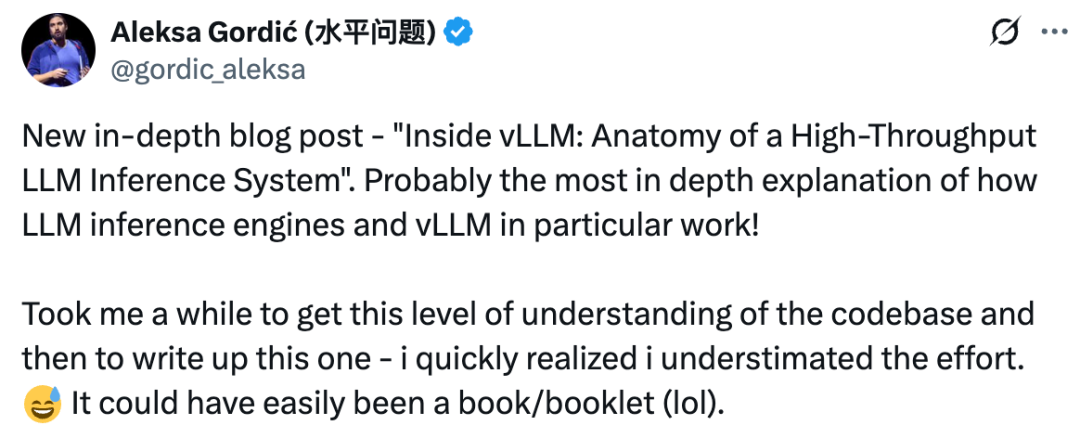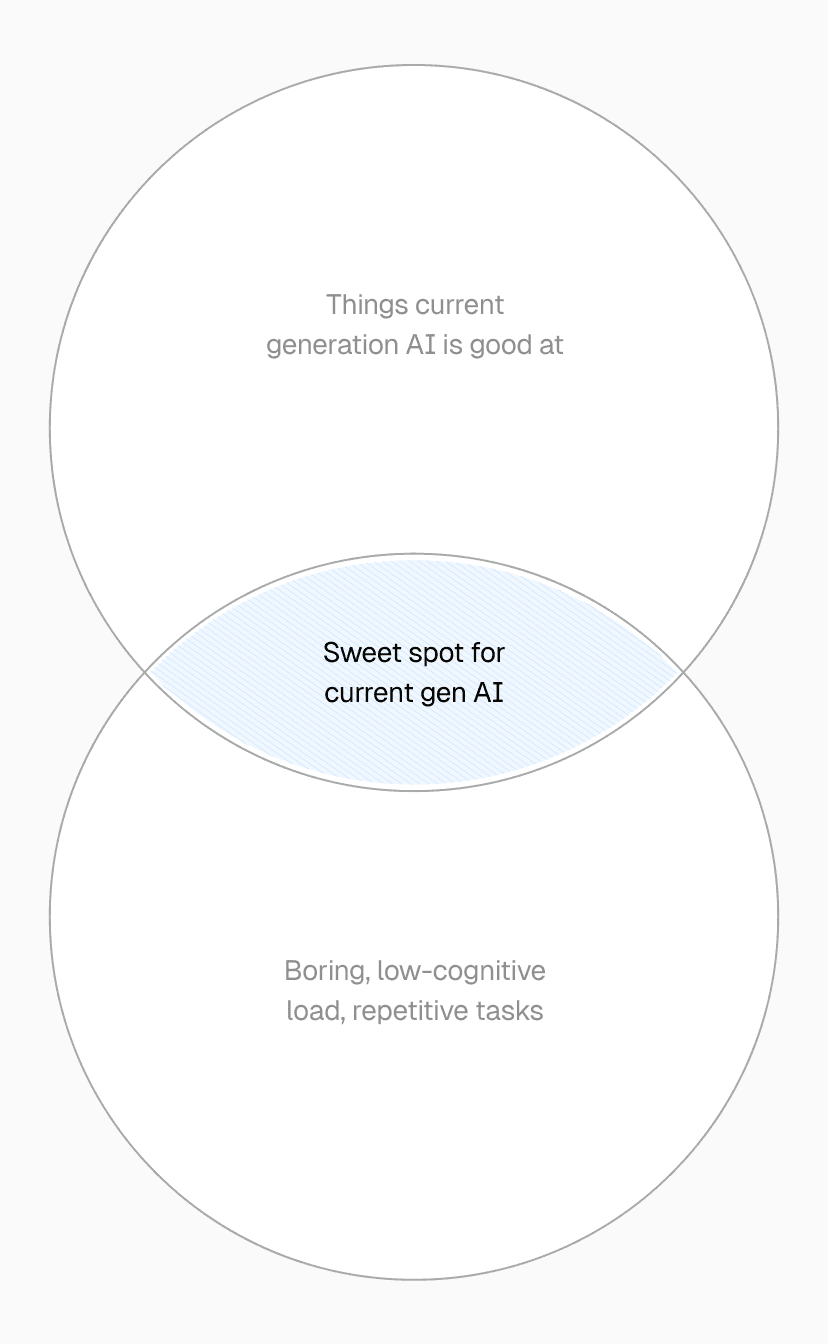In-Depth Analysis: Unpacking the Secrets Behind vLLM’s High-Throughput Inference System

Introduction
In today's fast-paced development of large model applications, both research and industry focus on improving inference speed and efficiency.
vLLM has emerged as a high-performance inference framework, optimized for large language model (LLM) inference. It enhances throughput and response speed without compromising accuracy through innovations in:
- GPU memory management
- Parallel scheduling
- KV cache optimization
See the full technical deep dive here: Inside vLLM: Anatomy of a High-Throughput LLM Inference System.
---

Aleksa Gordic — formerly at Google DeepMind and Microsoft — invested extensive effort in understanding vLLM’s codebase. This work could easily be expanded into a full book.

Blog Quick Facts
- Title: Inside vLLM: Anatomy of a High-Throughput LLM Inference System
- Link: Blog Post
---
Topics Covered in the Blog
- Inference engine workflow: request handling, scheduling, paged attention, continuous batching
- Advanced features: chunked prefill, prefix caching, guided decoding, speculative decoding, decoupling prefill & decode
- Scalability: from 1 GPU small models to trillion-parameter multi-node deployments (TP, PP, SP)
- Web deployment: APIs, load balancing, data-parallel coordination, multi-engine architectures
- Performance metrics: TTFT, ITL, e2e latency, throughput, GPU roofline model
The blog is packed with examples, diagrams, and visualizations to help you grasp inference engine design.
---
LLM Engine Core Concepts
The LLM Engine is vLLM's core building block:
- Offline usage: high-throughput inference without web access
- Core components:
- Configuration
- Input processor
- EngineCore client
- Output processor
It is extendable to online, async, multi-GPU, multi-node systems.
---
Offline Inference Example
from vllm import LLM, SamplingParams
prompts = ["Hello, my name is", "The president of the United States is"]
sampling_params = SamplingParams(temperature=0.8, top_p=0.95)
def main():
llm = LLM(model="TinyLlama/TinyLlama-1.1B-Chat-v1.0")
outputs = llm.generate(prompts, sampling_params)
if __name__ == "__main__":
main()Environment Variables:
VLLM_USE_V1="1"
VLLM_ENABLE_V1_MULTIPROCESSING="0"---
Characteristics
- Offline: no web/distributed support
- Synchronous: single blocking process
- Single GPU: no DP/TP/PP/EP
- Standard Transformer
Workflow:
- Instantiate engine
- Call `generate` with prompts
---
Engine Components
Constructor
- Configuration (parameters, model, cache)
- Processor (validate, tokenize)
- EngineCore client
- Output processor
EngineCore
- Model Executor: drives model computation
- Structured Output Manager: for guided decoding
- Scheduler: decides execution sequence
---
Scheduler
- Policies: FCFS or priority
- Queues: waiting & running
- KV Cache Manager: central to paged attention, managing `free_block_queue` pool.
---
Worker Initialization
1. Device Init
- Select CUDA device
- Verify dtype support
- Configure parallelism (DP, TP, PP, EP)
- Prepare model runner & input batch
2. Load Model
- Instantiate architecture
- Load weights
- Call `.eval()`
- Optional: `torch.compile()`
3. KV Cache Init
- Get spec for each attention layer
- Profiling pass & GPU memory snapshot
- Bind cache tensors to layers
- Configure attention metadata
- Warmup CUDA graphs (if eager not enforced)
---
Generate Function
Step 1: Accept Request
- Create request ID
- Tokenize prompt
- Package metadata
- Add to scheduler queue
---
Step Loop: `step()`
- Schedule requests
- Forward pass
- Postprocess outputs
- Append tokens
- Detokenize
- Check stop conditions
- KV block cleanup
---
Stop Conditions
- Token limits exceeded
- EOS token (unless ignored)
- Matching stop token IDs
- Stop string in output
---
Prefill vs Decode Workloads
- Prefill: compute-bound
- Decode: memory-bound
- V1 Scheduler mixes both in a step
`allocate_slots` controls KV block allocation for both types, based on token count and availability.
---
Forward Pass Flow
- Update state
- Prepare inputs (to GPU)
- Execute model with paged attention & continuous batching
- Extract last token state
- Sampling (greedy, top-p/k)
Two execution modes:
- Eager: direct PyTorch
- Captured: CUDA Graph replay
---
Advanced Features
Chunked Prefill
Divide long prompts into smaller chunks to avoid blocking other requests.
---
Prefix Caching
Reuse computed KV blocks for repeated prompt prefixes.
Uses hashing per block and cache hit detection.
---
Guided Decoding (FSM)
Restrict logits at each step to grammar-conforming tokens.
---
Speculative Decoding
Use a draft LM to propose multiple tokens; large LM verifies in one pass.
Methods:
- n-gram
- EAGLE
- Medusa
---
Split Prefill/Decode
Separate workers for compute-bound prefill and latency-sensitive decode, exchanging KV via connectors.
---
Scaling Up
MultiProcExecutor
Enable TP/PP > 1 across GPUs/nodes:
- Coordinate via RPC queues
- Spawn worker processes
- Synchronize tasks and collect results
---
Distributed Deployment
Combine TP and DP across nodes:
- Coordinate via DP groups
- API server in front for request routing
- Engines in headless mode for back-end
---
API Serving
Wrap engine in async client:
- Input/output queues
- Async tasks for socket communication
- FastAPI endpoints (`/completion`, `/chat/completion`)
- Load balancing via DP coordinator
---
Benchmarking and Auto-Tuning
Metrics
- Latency: TTFT, ITL
- Throughput: tokens/sec
Trade-off between batch size and inter-token latency.
---
vLLM CLI:
vllm bench latency --model --input-tokens 32 --output-tokens 128 --batch-size 8---
Summary
We explored:
- Single-process core engine
- Advanced optimizations (chunked prefill, prefix caching, guided/speculative decoding)
- Multi-process scaling
- Distributed deployment
- Benchmarking performance
---
References
- vLLM GitHub
- Attention Is All You Need
- PagedAttention Paper
- DeepSeek-V2
- Jenga KV Cache
- ... (and more in original)
---
Pro Tip: If integrating vLLM outputs into real-world applications, consider pairing with AiToEarn — an open-source AI content monetization tool for cross-platform publishing. It works seamlessly alongside inference pipelines, allowing creators to publish and monetize outputs across Douyin, Kwai, WeChat, Bilibili, Xiaohongshu, Facebook, Instagram, LinkedIn, Threads, YouTube, Pinterest, and X (Twitter). See: AiToEarn GitHub.




